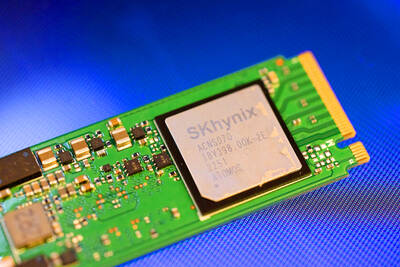High-tech industries worldwide are facing labor shortages and shipping restrictions from an outbreak of COVID-19 in China, with hardware manufacturers bearing the brunt of the effects, TrendForce Corp (集邦科技) said in a report yesterday, as it cut its shipments forecast for this quarter.
Lacking key components such as batteries and printed circuit boards due to an overall delay in Chinese production, downstream original design manufacturers (ODM) for consumer electronics would see a decrease in production, the Taipei-based market researcher said.
As a result, TrendForce cut its shipments outlook for laptops, LCD TVs and monitors by 12.3 percent, 4.5 percent and 5.2 percent respectively to 30.7 million, 46.6 million and 27.5 million units this quarter, compared with a previous forecast of 35 million, 48.8 million and 29 million units, the researcher said.
Contract laptop maker Quanta Computer Inc (廣達電腦) yesterday posted a 25.9 percent drop year-on-year in revenue to NT$62.96 billion (US$2.1 billion) for last month, with laptop shipments of 2 million units, as the Lunar New Year holiday reduced working days.
Contract electronics manufacturer Wistron Corp (緯創) said it shipped 1 million laptops last month, while revenue fell 20.13 percent annually to NT$40.49 billion.
Shipments of other consumer electronics, especially smart devices, also face challenges as ODMs grapple with shortages in labor, passive components and camera lenses, TrendForce said, adding that there would be an estimated 12 percent year-on-year decline in overall production this quarter to 275 million units, a five-year low.
Total smartphone shipments this year are set to fall by 1.3 percent on an annual basis to 1.38 billion units, it said, adding that it might further trim the figure due to uncertainties over the outbreak.
The researcher also predicted declines in shipments of game consoles and smart speakers for this quarter to 6.2 million and 23.2 million units respectively, falling by more than 10 percent each from last month’s forecast of 6.9 million and 26.4 million units.
Lockdowns and traffic constraints in China have left upstream suppliers, such as semiconductor companies and display panel makers, with an increasingly severe shortage of factor workers as they struggle to resume production, the report said.
Chinese foundry firms are likely to see lower factory utilization this quarter as a result, affecting China’s IC packaging and testing companies further down the stream, TrendForce said.
Meanwhile, the memory industry has mostly been spared from the outbreak, as its Chinese production remains unhindered due to its high level of automation, the researcher said, adding that DRAM prices would nevertheless increase this quarter, owing to insufficient inventory among end clients.

Taiwan Semiconductor Manufacturing Co (TSMC, 台積電) secured a record 70.2 percent share of the global foundry business in the second quarter, up from 67.6 percent the previous quarter, and continued widening its lead over second-placed Samsung Electronics Co, TrendForce Corp (集邦科技) said on Monday. TSMC posted US$30.24 billion in sales in the April-to-June period, up 18.5 percent from the previous quarter, driven by major smartphone customers entering their ramp-up cycle and robust demand for artificial intelligence chips, laptops and PCs, which boosted wafer shipments and average selling prices, TrendForce said in a report. Samsung’s sales also grew in the second quarter, up

On Tuesday, US President Donald Trump weighed in on a pressing national issue: The rebranding of a restaurant chain. Last week, Cracker Barrel, a Tennessee company whose nationwide locations lean heavily on a cozy, old-timey aesthetic — “rocking chairs on the porch, a warm fire in the hearth, peg games on the table” — announced it was updating its logo. Uncle Herschel, the man who once appeared next to the letters with a barrel, was gone. It sparked ire on the right, with Donald Trump Jr leading a charge against the rebranding: “WTF is wrong with Cracker Barrel?!” Later, Trump Sr weighed

LIMITED IMPACT: Investor confidence was likely sustained by its relatively small exposure to the Chinese market, as only less advanced chips are made in Nanjing Taiwan Semiconductor Manufacturing Co (TSMC, 台積電) saw its stock price close steady yesterday in a sign that the loss of the validated end user (VEU) status for its Nanjing, China, fab should have a mild impact on the world’s biggest contract chipmaker financially and technologically. Media reports about the waiver loss sent TSMC down 1.29 percent during the early trading session yesterday, but the stock soon regained strength and ended at NT$1,160, unchanged from Tuesday. Investors’ confidence in TSMC was likely built on its relatively small exposure to the Chinese market, as Chinese customers contributed about 9 percent to TSMC’s revenue last

LOOPHOLES: The move is to end a break that was aiding foreign producers without any similar benefit for US manufacturers, the US Department of Commerce said US President Donald Trump’s administration would make it harder for Samsung Electronics Co and SK Hynix Inc to ship critical equipment to their chipmaking operations in China, dealing a potential blow to the companies’ production in the world’s largest semiconductor market. The US Department of Commerce in a notice published on Friday said that it was revoking waivers for Samsung and SK Hynix to use US technologies in their Chinese operations. The companies had been operating in China under regulations that allow them to import chipmaking equipment without applying for a new license each time. The move would revise what is known